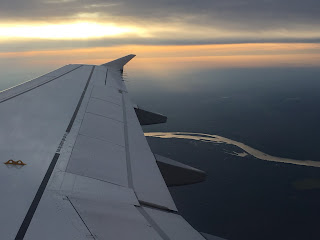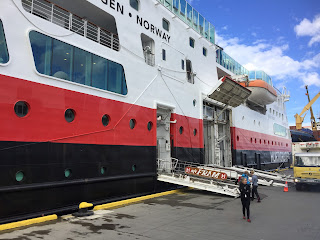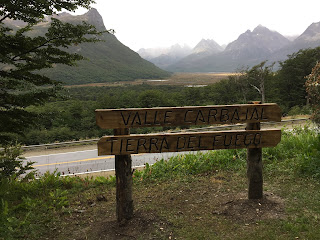Belgrade
Easter 2017
In the
literal sense, I love going the road less travelled. Two short flights with
Lufthansa, via Frankfurt, got me to a European capital which is definitely off
the beaten tourist track, but one which is undergoing a renaissance in having
downbeat areas being restored and gentrified, and which has, as it stands, a
wealth of fun, interest, and beauty to entertain the visitor.
Arriving at
Nikola Tesla Airport, named for the great Serbian scientist, I was greeted by
bonsai trees lining the passage to passport control, which was speedy, and
onwards to baggage reclaim. The carousels are quirky in that the as yet
unclaimed luggage appears to retreat into a car boot. My bag arrived quickly,
and out I went to meet my hackney driver whom I had arranged through Viator. He
provided me with an impeccably safe drive to my hotel.
I checked
into the Radisson Blu Old Mill Hotel, which is a revamped industrial mill
building, with the old chimney and yellow brick walls evident to the rear. The
interior is totally avant-garde with clever use of lighting. I was warmly
greeted at reception, and my luggage carried up to my room by a very helpful
and informative bellhop. We encountered an English bulldog in the corridor
outside his room, and I gave him a little scratch on his furrowed brow. The
door to my room was designed to stay in whatever position was required; it did
not slam closed on you. Every detail in the hotel was a little piece of
engineering and design, and I was pleased to have made a good choice of a place
to spend my three nights.
Breakfast
was quite a feast featuring a great variety of traditional and local
specialities, with explanations of what each item was. An orange juice squeezer
was there to fill your own glass. I was to discover that identical citrus
squeezers feature in all the city’s cafes. Home-baked breads were on offer,
local cheeses, a Serbian type quiche, traditional red pepper condiment, cold
fish, bacon, eggs, sausage, salads, yoghurts, fruit and pastries. I had a
private tour booked for myself online through Viator.
My Big
Belgrade Private Tour began with a visit across the beautiful modern cantilever
bridge (similar to the ones over the Boyne and in Dundrum) across the River
Sava to New Belgrade, an area of green spaces and buildings of various merit
and which divide opinions. There are those dreary functional communist era
blocks of flats devoid of aesthetic, and the ultra-smart new apartment
buildings and housing. A lot of the hotels, conference, cultural and sporting
facilities are located in this district, which locals consider to be the best
location to live in Belgrade. Floating nightclubs on the Sava and Danube
rivers, with DJs playing the ever popular Turbo-Folk mixes provide fun after
dark.
Back across
the river we hit what might have been real city traffic, only it was light
because of the Orthodox Easter weekend. In 1935 building commenced at the first
location where we stopped. Like the Familia Sagrada in Barcelona, Saint Sava’s Serbian
Orthodox Church, the largest ecclesiastical building in the country, is still
incomplete and awaits charitable donations to finish a large amount of interior
work. The great white edifice stands on a plateau away from the city centre,
and is only rarely used for worship as it awaits completion. Outside, sweet
stalls displayed colourful arrays of the traditional confectionary of Serbia,
the Serbian Love Heart.
The Parliament
Building is perhaps the most iconic of Belgrade’s structures, and its picture
features in news items and Eurovision jury votes. A very busy road passes
between it and a park full of trees, so it is quite difficult to get a good
picture of it. Also spoiling the picture was a giant protest banner across the
foot of the building protesting about Albanians killing Serbs. Kosovo is still
very much a hot issue and continuing legacy of the last Balkan war.
We drove
through the old Belgrade area of Dorcol, very much in need of face-lift, but
considered as the near future hotspot in the gentrification of Belgrade. A very
prosperous looking veterinary hospital is located here, reflecting the
popularity of pet animals. The city’s main marina is located here and due for
further development. In spite of current grittiness bohemian Dorcol is considered
a desirable place to live on account of its position in the heart of city life
and overlooking the Danube.
Kalemegdan
Fort is the greatest focus of touristic interest in Belgrade, and almost as
iconic as the Parliament building. Its fortified walls encompass a lovely and
interesting park which is free to enter by all denizens. Just beside the
fortressed park is the small and tidy city zoo mainly housing smaller creatures,
a popular attraction for a city of animal-lovers. Within the fortress moat and
buildings is the Military Museum with a fascinating display of tanks visible
from the bridge over the moat. A park of moving roaring dinosaurs which can be
“ridden” by children is a fantastic family attraction, and I know it would have
impressed or terrified me endlessly as a child; these creatures were of serious
dimensions, but would probably be forbidden in EU for health & safety
reasons. Aptly named Jurassic Park!
Zemun is a
very pretty old town surrounded by modern urban developments and is part of the
city of Belgrade. We parked along the café-lined esplanade by the Danube and
walked through the crumbling cobbled streets up the hill to Gardos Tower. From
here I got the classic view over Zemun town with its many spires and red roofs,
spilling sown to the broad Danube.
En route to
Tito’s mausoleum we drove along the most upmarket road in leafy Belgrade suburbia,
where stand some grand old embassy buildings and quite elaborate mansions, some
of them in need of renovation for want of money by the people who inherited
them. It wasn’t the kind of place you’d care to stop and take a picture on
account of the gun wielding guards outside the embassies.
Tito’s Mausoleum
is situated in a conservatory type building named the House of Flowers on
account of the maintenance of floral planting alongside the burial tombs of Josip
Broz Tito and his wife Jovanka Broz. Marshal Tito, the socialist dictator of Yugoslavia,
died one year after I visited the Croatian sector on my first foreign overseas
trip post Leaving Cert in 1978. On display is an elaborately carved writing
desk which belonged to him. However, he always considered his items as
possessions of the people which he made good use of, and left all his items to be put
on display for future generations to see, rather than pass them down through
his family and friends. My guide has mixed feelings about him, and considers
that he is quite a cut above most of the rest of the Soviet era despots, and
the ordinary people could afford a very nice annual family holiday in a decent
hotel in any Eastern Bloc destination of their choice. On location I visited a
museum which was filled with all the diplomatic gifts which had been given to
Tito by dignitaries from the many countries which he had encountered during his
leadership. It is a fascinating medley of items, some of them absolutely absurd
or grotesque items of supposed national pride by the donating countries and it’s
no wonder he put them aside for a museum rather than have them decorating his
house.
For lunch, the
driver brought me to at an atmospheric restaurant in the suburbs for and I had
choice of whatever I wanted a la carte. Usually on these set itinerary tours
you get a set menu, but I was given freedom to indulge. As it happened my
stomach was still fairly full from the large breakfast, so I decided on the
meat soup (more of a stew), bread, followed by cevap, which are minced pork balls a bit like
koftas and a bowl of Serbian salad, all washed down by a glass of beer. My
driver too enjoyed a glass of beer as this amount is permitted in Serbia. A
group of musicians moved through the various rooms of the restaurant playing
folk music.
After lunch
my driver announced that we were “going up the mountain”, the one and only
mountain in the region of gently rolling lowlands. Entering through the forest
park gate a narrow winding road brought us to the top of the modest peak where
a car park and restaurant looked out to the nearby stern concrete Avala Tower. A
short walk gave beautiful views of the surrounding country and brought us to
the Monument to the unknown Hero, a little temple perched regally at the tip
top of the hill, reached by a series of steps. It is dedicated to Yugoslav
soldiers, from all regions of former Yugoslavia, who fought in all wars
throughout the times.
Down the
hill we parked by Avala Tower, a 670ft concrete tower originally built in 1965
for television transmission. It looked stark and sinister against the bright
sunlight as we approached its entrance up a series of ramps. The original tower
was destroyed during the NATO bombing of Yugoslavia in 1999; no longer needed
as a TV transmitter, the locals missed their landmark badly and money was
raised to have it rebuilt purely as thing of beauty, if you could call it that.
Like many Belgraders do on a weekend outing, we ascended to the viewing area by
lift and got a bird’s eye glimpse of the distant city, Sava and Danube overs,
of the mountain very close by, and of a delightful little wooded Orthodox
church in the woods below.
My driver
suggested we drive back to the city via a different route which took me past a
series of very fine new mansions, about 6 or more bedrooms to each, with plenty
of green space around them. I remarked on the size of these houses and he said
that they go for a song, about €75K each, as nobody wants to live far outside
the city and have to drive in and negotiate traffic every day. They have to
build them big out this far to get any buyers at all. Reaching back to my hotel
I said that the commute from those grand houses is no length, and he replied
“But its Orthodox Easter Saturday”.
For the
second day of my weekend in Serbia, I originally had the idea to explore some
of the fascinating areas outside the capital, but this being Orthodox Easter
Sunday, nobody in the country was working. It’s the equivalent to Christmas Day
in Dublin. There are mountains, film sets, a historic train, monasteries,
fortifications, vineyards, notable towns, caves, and craft centres to see and
visit. But I resolved to see Belgrade more intimately, on foot, and I’m so glad
I did. This is a place that deserves a longer weekend than I had planned.
It was a 25
minute, somewhat uphill walk into the city centre, the quickest route being via
a narrow grey backstreet. I encountered plenty of folk walking their dogs along
the way; everybody seems to love their pets here as in most European cities. Give
me a map, I love navigating my way around on foot, and was enjoying my
adventure in spite of some neurological difficulties with legs and balance; I
was going at my own pace, nobody to follow, nobody to rush me. I didn’t
encounter even one dodgy looking person or a homeless individual, a far
different scenario from my native Dublin.
I passed by
a fine old railway steam locomotive tucked in close to a grand building; it was
the Railway Museum, of course closed today. Shortly I came upon the Hotel
Moskva, the most iconic hotel in the city, a relic of the Russian Empire, built
in 1903. A beautiful building, with the city’s first font of potable water
placed right in front of it.
Soon I came
upon Republic Square, the very centre of the city, where all the people gather
for various reasons. However, being my equivalent of Christmas Day, few were
here. A crane and building works were taking place in front of City Hall,
somewhat spoiling the photographic opportunity. But I had it almost all to
myself, probably a unique experience!
I stopped
off at one of the cafes which was open on this day of great significance in the
religious calendar, and enjoyed a long glass of freshly squeezed half orange
and half grapefruit juice, which seemed to be a staple thirst quencher
throughout the city.
By this time
I was strolling down Mihailova Street, the main pedestrianised shopping street
of the city, an impressive thoroughfare which started as a big city street and
ended as a pretty small town style street at its far end at the main entrance
of the Kalemegdan Fort.
Not much was
open, and few enough people were in town. It made for relaxed viewing of some
fine buildings, especially the intricate architectural detail which could be
examined looking upward. In every old European city I visit I just love to
stand and gaze at such features.
The pharmacy
was open and I took the opportunity to look in and examine the lovely wooden
counters and shelves, a throwback from history. But then I recall my visit to
Yugoslavia in 1978 and the local chemist shop had the same style interior,
harking back to the time when the first pharmacy in Europe opened down south in
Dubrovnik. A small souvenir shop was open and I bought a couple of items to
take back to my work colleagues. Also open was a bookshop which proved a magnet
to the few folk wandering down the street.
One of the
cafes had books old and new placed casually about, with the people inside
relaxing over a cup of coffee and a good read. A tea shop had in its window-display
an array of old teapots from far and wide, and another café featured old coffee
cups in its windows. A Balkan restaurant had a large canopy of red umbrellas
across a patio by its entrance. I was later to read that such a display of umbrellas
is a traditional feature in Balkan establishments, especially in Bulgaria.
Throughout
the city, fountains are a popular feature. They come in all forms and sizes,
and have given safe drinking water for decades. Nobody bothers with buying
bottled water here, they carry around an empty one and fill it at the next
drinking font, which is invariably of decorative merit.
Rain had
been promised by the national forecast and it delivered exactly as promised.
Starting out grey, it turned drizzly, then wet, and finally constantly
saturating. My waterproof camera was challenged only by blurring of the images,
but survived electronically. I could hardly see anything through my misty wet
glasses and beyond my hood. Yet I was having fun in my own kind of way! A city
is the best place to be in rotten weather; the wet shows up detail in the glistening
stone, and no sun casts buildings as mere silhouettes.
It was
raining quite heavily by the time I reached the beautiful Pionirski Park in
front of the Parliament building. Purple and white flowers graced the beds,
with a couple of attractive fountains and inspiring statues to grace the
picture. Several important buildings surround the park, and of course the copper-domed
Parliament building is the main city icon in the manner than the Eiffel Tower
is of Paris. The statue I loved best was that of the Serbian Fauvist artist
Nadezda Petrovic, it is in my opinion a masterpiece of simplicity and grace and
its image lingers strong in my head.
The rain was
at its peak as I turned downhill along the long grand avenue leading to my
hotel. I had done nearly four hours
walking, in not the best of shape, and crumpled down on my cosiest of beds
until I enjoyed a nice evening meal and a nightcap.
My Lufthansa plane took off and followed the silvery Danube
for some while. Coming towards Frankfurt the aircraft very suddenly started
pitching, fortunately nobody was making their way to the toilet at the time or
there could have been injuries. It only lasted a few moments, then the captain
came on to apologise for this unexpected disturbance which happened during entry
through a small cloud which happened to have strong updrafts. We continued to
Frankfurt without further incident, and I caught my connection homeward bound
to Dublin.
-o-o-o-o-o-


















































